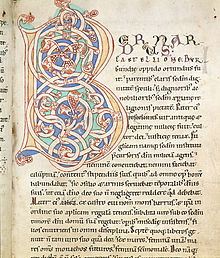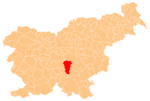Stična Abbey
History
The abbey foundation charter was issued in 1136 by Pellegrinus I, Patriarch of Aquileia, although monastic life had begun a year earlier, in 1135. The monastery at Stična quickly became an important religious, cultural, and economic centre.
In addition to an ordinary school, the monastery also operated a music school, where the Renaissance composer Jacobus Gallus is believed to have received his earliest musical education. The successful life of the monastery was hampered by Ottoman raids, and was burned and looted twice. In 1784 Emperor Joseph II abolished the monastery, dissolved under the Josephine Reforms, but it was resettled again in 1898 by monks from Mehrerau Abbey on the shore of Lake Constance.
During the Second World War, the Partisans use the abbey as a prison for priests that they had captured.
Stična manuscript
The monastery's scriptorium was already producing illuminated Latin manuscripts in the 12th century, and it was here that the Stična manuscript, written in Slovene, was produced in the 15th century.

Architecture
In terms of architecture, abbey has been repeatedly modified, leaving Romanesque and Gothic traces in Baroque buildings. The oldest core of the abbey has been preserved. The abbey has a basilica dedicated to Our Lady of Sorrows, which serves as a parish church. The abbey and Romanesque basilica are recognized as cultural monuments of national significance.
List of abbots

| The list of abbots | |
|---|---|
| Name | Period |
| Vincencij | 1135/36–1150 in 1163–1167/68 |
| Aldeprand | between 1150–1163 |
| Folknand | 1167/68–1180 |
| Bernold | 1181–21.
februar 1226 |
| Konrad | approx. 1230–approx. 1250 |
| Janez Gall | approx. 1250–approx. 1260 |
| Ditrik | approx. 1260–1266/67 |
| Konrad | 1266/67–approx. 1280 |
| Henrik | approx. 1280–1302 |
| Rudolf | 1303–approx. 1314/15 |
| Friderik Limpach | approx. 1315–approx. 1321 |
| Nikolaj Hmeljniški | approx. 1321–approx. 1326 |
| Eberhard Planinski | approx. 1326–1332 |
| Štefan | 1332–1333 |
| Oton | 1333–1335/36 |
| Janez | 1336–1341 |
| Nikolaj | 1341–1348 |
| Peter | 1348/49–1360 in 1365–1366 |
| Arnold | 1360–1365 in 1366–1370 |
| Jakob | 1370/71–1382 |
| Andrej Čreteški | 1382–1387/88 |
| Albert Lindeški | 1388–13.July 1405 |
| Peter Limschak | 13. July 1405 – 1427/28 |
| Lavrencij Forrer | 1427/28–1431/32 |
| Emerik Perenny | 1432–approx. 1441 |
| Matej Zaletel | 7.February 1441–10.September 1449 |
| Gerhard | 1449/50–1450 |
| Ulrik | approx. 1450–1481 |
| Ožbalt | 1481/82–1487/88 |
| Tomaž | 1487/88–13.December 1494 |
| Martin | 13.December 1494 – 1499/1500 |
| Janez | 1499/1500–approx. 1511 |
| Tomaž | 1511/12–before 13.March 1516 |
| Urban Gall | before 13.March 1516–22.August 1523 |
| Janez Glavič | 22.August 1523–4. September 1530 |
| Klemen Gutsold | before 14.November 1530 – 1533/34 |
| Janez Cerar | 1533/34–1549 |
| Wolfgang Neff | before 6.March 1549–18.March 1566 |
| Janez Zeisel | 24.April 1566–21.September 1576 |
| Jakob Klafferle | 31. januar 1577–7. marec 1580 |
| Lavrencij Zupan | 21.April 1580–26.December 1600 |
| Jakob Reinprecht | 14.April 1603–13.January 1626 |
| Matej Majerle | 21.March 1626–4.June 1628 |
| Janez Anžlovar | after 25.July in before 30.August 1628–13.March 1638 |
| Janez Weinzirl | 26.April 1644–2.December 1660 |
| Maksimilijan Mottoch | 2.January 1661–18.January 1680 |
| baron Ludovik Raumbschüssel | 26.May 1680–5.December 1687 |
| baron Anton Gallenfels | 14.February 1688–12.April 1719 |
| baron Aleksander Engelshaus | 28.June 1719–9.March 1734 |
| Viljem Kovačič | 25.July 1734–12.May 1764 |
| baron Frančišek Ksaverij Taufferer | 27.September 1764–25.Oktober 1784 |
== Picture Gallery
-
From the north
-
Inner yard
-
Inner yard
-
Refectory
-
Cloister
Institutions and festivities related to the abbey
They abbey at one point had a high school inside, at the present there is a Museum of Christianity and a parish of Stična. Every year there is a cultural youth festivity called Stična mladih.
Museum of Christianity in Slovenia
The Museum is state owned and serves as a central museum institution on the topic of sacral heritage.

Sitik d.o.o.
Abbey of Stična made a part of the economical tourism and herbalic pharmacy available to the laymen. A small teahouse with kindergarten toys and tourist shop is pretty. Pharmacy of late cistercian herbalist Simon Ašič has become an important reminder of the gardening that was a traditional occupancy of the monks. Sittik d.o.o. handles even some serious gardening and nourishes on 4000 m2 about 250.000 room plants every year.
Festival Stična mladih
Festival Stična mladih is a yearly event where about 8000 young people come to have fun. The entire program in mostly organized and led by young people from Slovenia. The event was inspired by the World Youth Day, theme of a festival is copied from the theme of the World Youth Day, even the program of the festival is inspired by the Popes message to the young.
Stiška gimnazija, Gymnasium of Stična
Josip Jurčič High School was founded in 1945 as an incomplete high school. In 1946 the teachings began in the abbey. The School became complete in 1950, but more than once existence of the school was questionable. In 1970 school got the name after the known local writer and journalist. In 1980 Municipality of Grosuplje decided to move away from the Abbey in to bigger quarters. In June 1984 the last generation of students who were taught in the abbey concluded their high school education.
References
- ^ Ferenc, Tone; Ževart, Milan (2002). Dies irae: četniki, vaški stražarji in njihova usoda jeseni 1943. Ljubljana: Modrjian. p. 527.
- ^ Nadrah, Ignacij (2010). Spomini in semeniška kronika 1941–1944 Ignacija Nadraha. Ljubljana: Arhivsko društvo Slovenije. p. 192. ISBN 978-961-6143-32-5.
- ^ Benedik, Metod (1991). Zgodovina Cerkve na Slovenskem. Ljubljana: Inštitut za zgodovino Cerkve (Teološka fakulteta v Ljubljani). p. 230.
- ^ Mlinarič, Jože (1995). Stiška opatija 1136–1784. Novo Mesto: Tiskarna Novo mesto, Dolenjska založba. pp. 881–882. ISBN 961-6000-32-2.
Sources
- Jože Mlinarič, Stiška opatija 1136-1784, Novo mesto 1995, Dolenjska založba
- Ivan Stopar, Hrami tišine, Ljubljana 2009, Viharnik
- Vanja Požegar, Cistercijani in nastanek cisterc na Slovenskem, Maribor 2009, bachelor's thesis
- http://cistercijani.sticna.si/
- http://sticna.rkc.si/sl/
- http://sitik.si/
- Bahor, Stanislav: "Skriti knjižni zakladi" Ljubljana, NUK, 2009 COBISS 246170368
- Trnovšek, Tadej: "Zaklad pisarja Bernarda" Stična, Muzej krščanstva na Slovenskem, 2011 COBISS 259190784
- Golob, Nataša: "Srednjeveški kodeksi iz Stične: XII. stoletje", Ljubljana, Slovenska knjiga, 1994COBISS 34920193
External pages
- Stična Abbey
- Consecration to the Hearts of Jesus and Mary
- Stična Youth Festival (in Slovene)
- Stična Manuscript. National and University Library of Slovenia.





